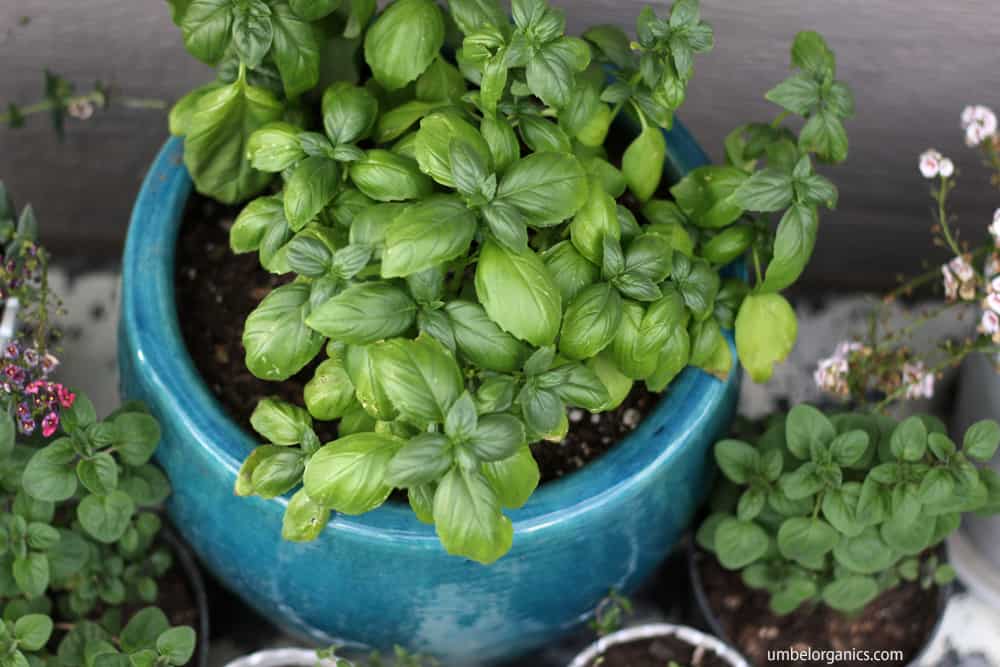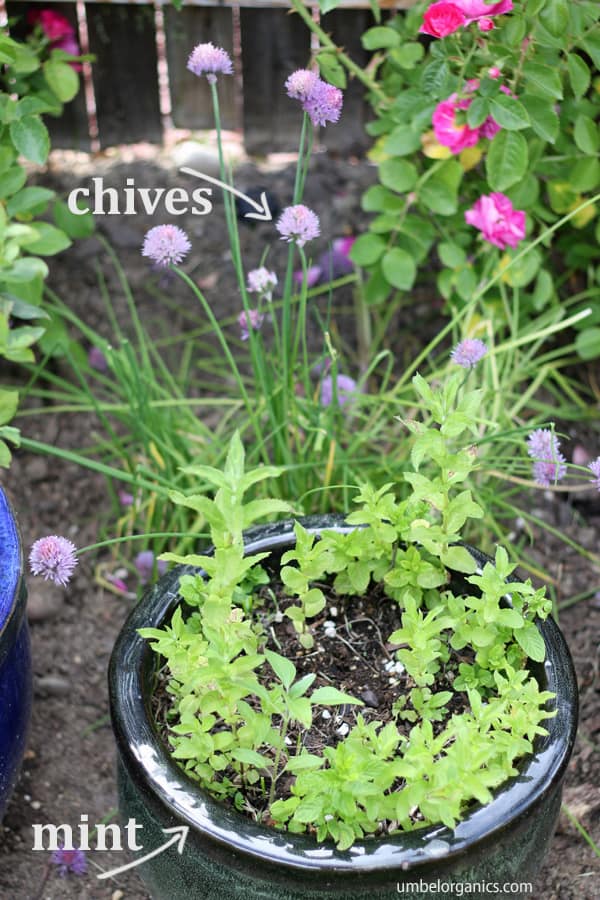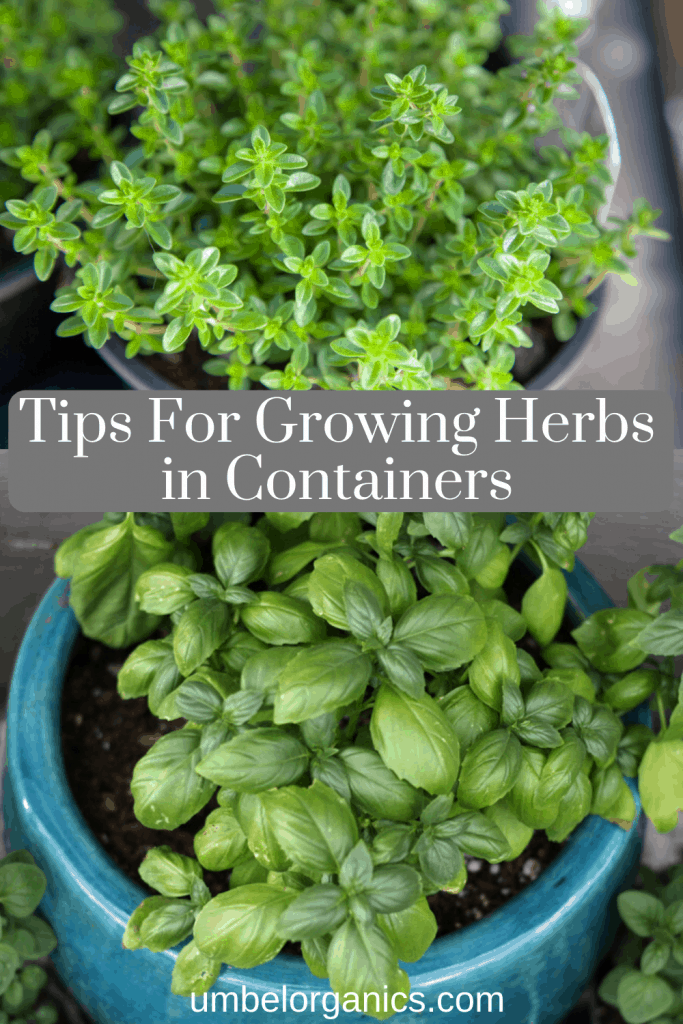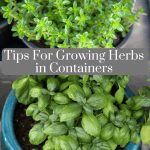Tips For Growing Herbs In Containers
Grow herbs right out your back door with these simple and easy tips. From sweet basil to aromatic thyme, we’ve got all the details you need to get started now on your container herb garden.

Disclosure: This post contains affiliate links, which means if you make a purchase through these links, we may receive a small commission at no extra cost to you.
Have you ever bought an overpriced clamshell of herbs only to use a few leaves before they spoil? Fresh herbs add a burst of flavor to your favorite recipes, but store-bought can be expensive and tasteless. That’s why we grow our own container herbs.
It’s so easy to keep a few pots full of herbs outside in the summer. I love opening the back door and snipping a few basil or oregano leaves for a recipe. We do plant parsley in our raised garden beds and incorporate chives into our landscape flower gardens, but most of our herbs end up in pots right by the back door. Choose a non-toxic planter or container that won’t leach harmful chemicals for peace of mind.
Growing Herbs In Containers
- Most herbs grow well in containers, and you can grow more than one type of herb together in the same pot.
Tip: Plant herbs with similar watering, sunlight and soil requirements together. Rosemary and Sage like hot and dry and make good container companions. Parsley and Basil like steady moisture and work well in the same container.
- Not sure what container to use for planting herbs? As long as the container has drainage holes, it will work. Most herbs don’t have large root systems and can fit in smaller containers.
TIP: If your container doesn’t have bottom holes, you can use a nail or drill to create DRAINAGE HOLES in the bottom. Smaller containers have less soil, so you may have to water more often.
- Potted herbs need soil with additional drainage. Don’t use soil from your garden.
Tip: Use a high-quality organic potting soil when potting-up your herbs. If the potting soil already contains organic fertilizer, you don’t need to add any more at planting time.You will need to add additional fertilizer every few weeks during the growing season since fertilizer easily gets washed out of pots during frequent watering. We use organic fertilizer containing fish emulsion or mix in a handful of organic granular fertilizer with the top layer of potting soil.
- Mix herbs with annual plants in a decorative planter for a balanced arrangement. Herbs add color, texture and aroma to outdoor planters.
Tip: Make sure your annuals have similar water, soil and sun requirements as the herbs.
- Most herbs need full sun for about 6 hours a day.
Tip: Move the containers around throughout the growing season to get the proper amount of sun. If you live in a warmer climate, you may need to shade herb containers during the hottest part of the day.
- Water Regularly. The soil in small containers can dry out quickly. If the potting mix is dry and pale, it’s time to water. We use a non-toxic hose that doesn’t contain phthalates, heavy metals or PVC.
Tip: Water either in the early morning or at night so the water won’t evaporate as quickly. Place potted herbs near a timed sprinkler if you’ll be away for an extended period of time.
- It’s okay to use garden center (nursery) starts – you’ll be able to harvest sooner. Some herbs are hard to grow from seed, so transplants are a good way to start herb gardening.
Tip: Check the soil moisture and make sure the soil is not dried out before buying. Avoid starts with wilted stems and leaves.
- Harvest your container herbs regularly. The more you pick, the more you’ll get.
Tip: Pinch off the growing tips—this causes the plant to produce more branches and become fuller, and you’ll have more leaves to harvest. Also pinch off any budding flowers to keep the leaves at peak flavor all summer.
- In the fall, bring your container herbs indoors and place them by a sunny window.
Tip: Dry your herbs and create culinary herb combos such as pizza spice or herbes de Provence. They make great DIY gifts.

Basil
Basil is a warm weather annual, and it’s a great starter herb since it’s easy to grow. From sweet basil to lemon to Thai, basil has a lot of varieties with subtle flavor differences. Grow a few varieties for a range of culinary dishes.
- Sun: Full sun
Soil: Moist but well-drained
Harvest: Pinch topmost leaves from stem. This encourages lateral growth throughout the rest of the plant and reduces the risk of early flowering. Clip or pinch off flowers if they start to form. Once flowering, leaves are lower quality since the energy is longer directed into flower production.
Chives
Chives are easy to grow perennials and can be planted throughout landscaping or in containers.
- Sun: Full sun or partial shade
Soil: Moist soil
Harvest: You can begin harvesting leaves as soon as they are big enough to clip and use. Cut from the outside of the clump, about 1-2 inches above soil level, always leaving plenty to restore energy to the plant.
Cilantro
Cilantro is an annual that bolts quickly in hot weather. It grows best in cool weather in the early spring or fall.
- Sun: Full sun
Soil: Well-drained but moist
Harvest: Cut leafy stem near ground level.
Dill
Dill is an annual that loves warm yet mild weather.
- Sun: Full sun
Soil: Moderately moist but well-drained
Harvest: Pinch off entire branches with leafy fronds forming from the stem.
Mint
Mint is a perennial herb that likes to spread, so growing it in a pot is a good choice for gardeners with limited space. There are lots of varieties of mint, including peppermint, chocolate mint, spearmint, pennyroyal and pineapple mint. Plant a few varieties and see what you like.
- Sun: Full sun or partial shade
Soil: Thrives in most soil types
Harvest: Harvest leaves individually by pinching off at the stem, or cut the stems 1 inch from the ground. For a large harvest, wait until just before the plant blooms and you’ll get the most intense flavor. Cut the whole plant to just above the first or second set of leaves.
Oregano
Oregano is a perennial herb that’s great for containers since it doesn’t spread much.
- Sun: Full sun
Soil: Well-drained soil
Harvest: The flavor of oregano intensifies the more sun it gets and peaks just before it blooms. Harvest the leaves as you need them, once the stems are at least 4 inches tall. Regular trimming of oregano encourages new growth and fullness. Remove the leaves from the stems by running your fingers up the stem and the leaves will fall into your hand.
Parsley
Parsley is a biennial plant that comes back for two gardening seasons. Parsley has both curly leaf and flat leaf varieties.
- Sun: Full sun or partial shade
Soil: Moist soil
Harvest: Wait until the stems are divided into three sections before harvesting and cut the leafy stem at the base.
Rosemary
Rosemary is a perennial that likes heat and is drought tolerant.
- Sun: Full sun
Soil: Well-drained
Harvest: Cut off the top 3 inches of each sprig. Rosemary can be brought inside for the winter and placed near a sunny window, just be sure to keep the soil moist when indoors for optimal growth.
Sage
Sage is a perennial herb that’s hardy and easy to grow.
- Sun: Full sun
Soil: Moist soil
Harvest: Pinch the leaves off individually or cut the stem
Tarragon
Tarragon is a perennial that thrives in mild climates.
- Sun: Full sun and partial shade
Soil: Moist, well-draining soil and it tolerates drought well
Harvest: Harvest regularly and cut the leaves off as you need them. Remove the leaves from the stems by running your fingers down the stem from tip to base.
Thyme
Thyme is a perennial herb that’s easy to grow.
- Sun: Full sun
Soil: Well-drained
Harvest: Cut the bottom of the stem and strip the leaves from the stem.



I have not had much luck but I think I will give it another try this year!
Virginia Hope Vinch
Keep trying, and good luck!
Great information
Ive been planting herbs for several years
I will try it again in containers/ pots this year!
Love your tips!
Thank you, and we’re glad you found this helpful!